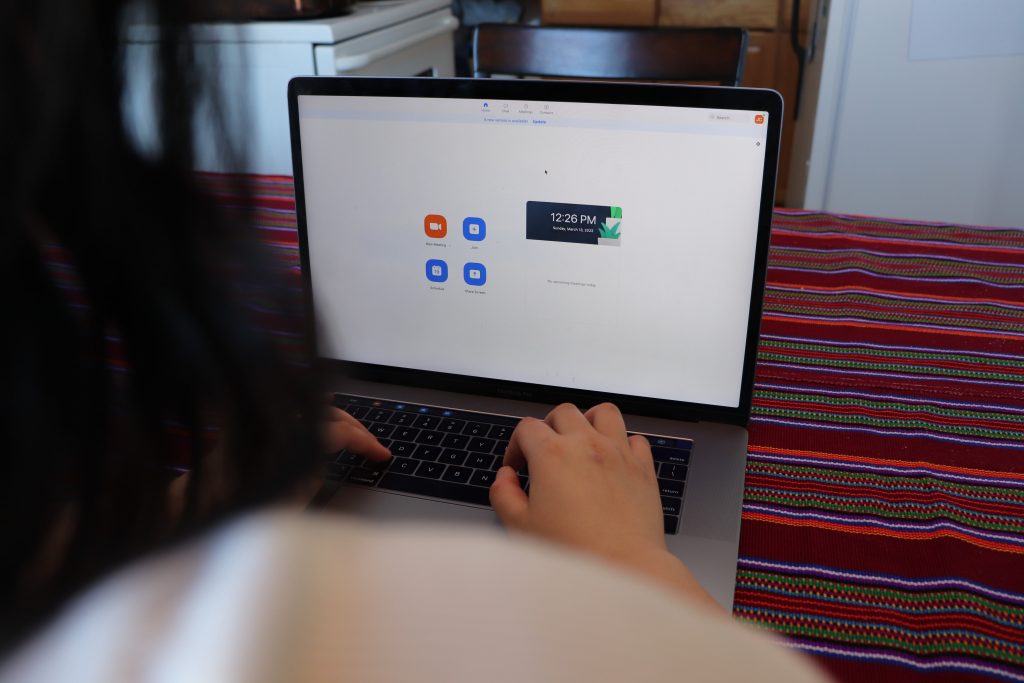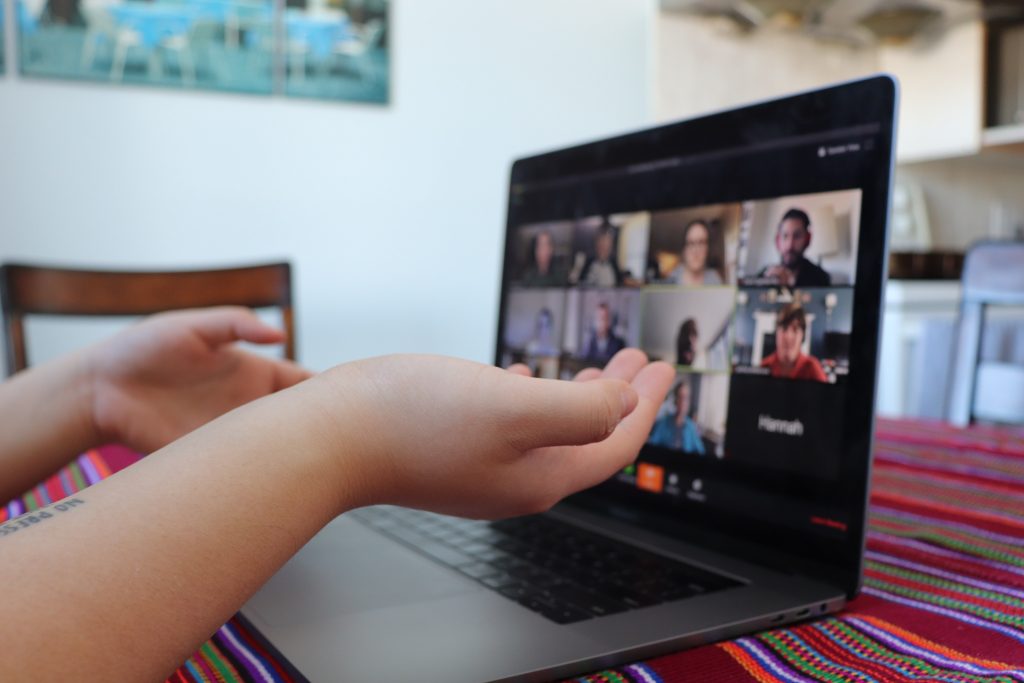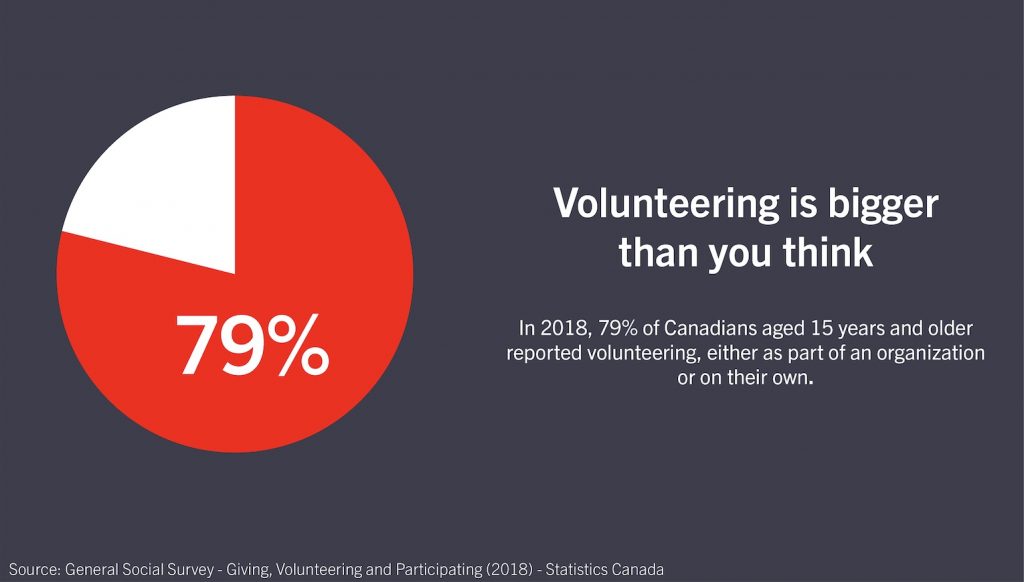Listen to the article:
A computer starts up.
Its fans are running loudly.
Krysta Wojtowicz navigates her desktop and clicks on Microsoft Teams, an app that is now practically a household name.
Wojtowicz joins a Teams channel and is met with a screen full of welcoming and friendly faces.
The people on her screen are Agency Liaison Volunteers; she is one of them.
A lot of the work Wojtowicz does as a part of being an Agency Liaison Volunteer includes talking with United Way Winnipeg’s Agency Partners to renew funding contracts to allow them to continue to deliver programs and care through tough times. Now much of her work is done virtually.
Volunteering has always helped Wojtowicz feel less isolated, and now that the pandemic has changed almost every aspect of our lives, virtual volunteering continues to do so.
“It was really easy to feel isolated, especially in those early days of lockdown,” said Wojtowicz.
But just like other sectors that were able to move online, so did volunteering.
Coyote Communications, a website run by Jayne Cravens, a communications and volunteer involvement consultant, researcher, and trainer, defines virtual volunteering as: “A term describing a volunteer who completes tasks, in whole or in part, off-site from the organization or person being assisted, using the Internet and a computer, tablet, smart phone or other Internet-connected device.”
Many organizations that rely on volunteers turned to this format when it became unsafe to ask people to work in person, and for some organizations, it was the only way to stay afloat and continue operations. One of these organizations that shifted to virtual volunteering was United Way Winnipeg, where Wojtowicz helps out as an Agency Liaison Volunteer, a chair on the Healthy Neighbourhoods Impact Council, and a part of the Community Investment Committee, which votes on funding recommendations.
Virtual Volunteering with United Way Winnipeg:
United Way Winnipeg is a non-profit organization that helps over 100 agencies across the city deliver support and services to thousands of Winnipeggers every day. Some of United Way Winnipeg’s agency partners include Main Street Project, Mount Carmel Clinic, the Women’s Health Clinic, and Koats for Kids. In early 2020, United Way Winnipeg staff and volunteers shifted their works and meetings online through applications like Microsoft Teams and Zoom.
“Those tools really allowed us to continue on with the important work that we’re doing in community and with our volunteers,” said Tamara Ingrilli, senior manager, capacity building, at United Way Winnipeg. “And I think having tools that are accessible or that were accessible not only to us as United Way, but more broadly to folks in the community. That was really important in that transition.”
Moving to virtual volunteering had its challenges, especially around using new technologies. United Way Winnipeg staff did their best to help volunteers to troubleshoot these issues, especially in the first few weeks, when meeting online was relatively new to everyone. They prioritized communication and let volunteers know that staff support was available if they needed help.
“One of the things that we did as staff is we tried to develop a couple of information sheets that we could share with our volunteers, if they run into any issues, connection issues that they could refer to for troubleshooting and of course, we tried to communicate clearly with everyone that if anybody ran into issues that they could of course reach out to staff and we would do the best to help support them along that,” said Ingrilli.

From Wojtowicz’s perspective, the transition online created new problems, including technical difficulties, “Zoom burnout,” and the loss of personal connection.
In the journal Technology, Mind, and Behaviour, a peer-reviewed article looks into possible explanations for zoom fatigue and burnout. The writer concludes four possible things explain the phenomenon: excessive amounts of close-up eye gaze, cognitive load, self-evaluation from staring at video of oneself, and constraints on physical mobility.
While connection to the community remains strong on the virtual platform, Wojtowicz and many volunteers find that opportunities to make personal connections are sometimes missing from virtual volunteering.
“When you’re in a general virtual meeting room and say it’s a large group, again even when it’s not too large, it’s tough not to talk over people and keep the conversation going,” said Wojtowicz. “And something that’s missed before and after meetings is that personal connection and the stories that you get to share.”
Ingrilli agrees.
“There are so many dynamics and nuances of in-person connections, work, volunteering, that are just not possible with virtual options,” said Ingrilli.
Although virtual volunteering lacks the opportunities for personal connection possible through in-person volunteering, it creates opportunities for more accessibility, and allows organizations like United Way Winnipeg to continue to get their work done safely for communities across Winnipeg.
“This experience has shown us that virtual volunteering is possible and that is it not inaccessible, or kind of out there somewhere,” said Ingrilli. “It is a tool that we can use.”
Wojtowicz explained that a lot of the volunteers have full-time jobs and often go straight from work to a meeting, so joining in virtually from the comfort of their homes is a positive. She said using Zoom or Microsoft Teams works particularly well to facilitate learning or other virtual opportunities for large groups of volunteers.
It gives you that convenience to be able to continue to gather, but to do so in a more convenient and efficient way,” said Ingrilli.
Neither Wojtowicz or Ingrilli think virtual volunteering will be predominant over in-person volunteering since many people miss the one-on-one connection, but the convenience and accessibility of virtual volunteering is too valuable to give up. Ingrilli said United Way Winnipeg will continue to offer it going forward.
“I think it has a place like Krysta was talking about in terms of accessibility. And I think it will continue to be an asset in how we work with our volunteers,” said Ingrilli.
A Quick Look at Virtual Volunteering:
While virtual volunteering has become more popular during the pandemic, it is not a new fad. It has been around since the late 90s.
In 1998, a non-profit organization called Impact Online was one of the first to mention and promote the idea of virtual volunteering.
“Many people actively search for volunteer opportunities they can complete via home or work computers, because of time constraints, personal preference, a disability or a home-based obligation that prevents them from volunteering onsite. Virtual volunteering allows anyone to contribute time and expertise to non-profit organizations, schools, government offices and other agencies that utilize volunteer services, without leaving his or her home or office,” reads an excerpt from Impact Online’s 1998 site archived by Coyote Communications.

The changes COVID-19 has brought to volunteering has been well documented.
When the 2020 Tokyo Summer Olympics came around, 80 000 people could no longer volunteer, restricting many from pursuing volunteering as their leisure activity, writes Erik L. Lachance in a peer-reviewed article published in July 2020 by the journal Leisure Sciences.
“This negative impact on volunteering is relevant for organizations and events given the unpredictability of COVID-19 and the breadth of social distancing measures. However, and while individuals may not be able to fulfill their volunteering activities in-person, this threat creates an opportunity for virtual volunteering (VV),” writes Lachance.
Lachance also said that because of the pandemic and its direct impacts on societal circumstances, “it is important to discuss VV — its opportunities and challenges — as this form of volunteering is the only viable option for this leisure activity.”
Virtual volunteering opportunities are found across the country. One example is Beyond the Wards Canada, a non-profit based out of Toronto, that is taking the virtual volunteering model and reaching people Canada-wide with their approach.
Virtual Volunteering with Beyond the Wards Canada
Beyond the Wards Canada, was started after the first wave of COVID-19 by three Toronto university students, to help recognize people and essential workers who are outside the limelight.
“We found that a lot of people who were being recognized were in the medical profession, and obviously we don’t want to detract from the amazing work they do,” said Matthew Ferguson, one of the co-founders of Beyond the Wards Canada. “But we found that a lot of people who work in different jobs that maybe have been previously underappreciated, were also being underrecognized during the pandemic.”
These jobs include those on the frontlines other than essential medical workers such as janitors, bus drivers, postal workers, and more.
The initiative recognizes and acknowledges these underappreciated professions through virtual volunteer engagement.
On their homepage, Beyond the Wards Canada includes a submissions page where people can submit videos, written messages, and artwork to share their gratitude for these underacknowledged occupations. They also have a sub-project called Stories Unmasked, which delves into the experiences of these underrecognized workers and looks at what challenges they may have encountered.
“Some of the best things we receive are the thank you messages from workers who really appreciated them, said Ferguson. “We’ve had people say that it’s brought them to tears, which is really lovely.”
Currently, Beyond the Wards Canada has hundreds of submissions on their website from Canadians nation-wide.
Apart from being able to spread these messages of appreciation to hundreds of hard-working individuals, Ferguson said a big accomplishment for Beyond the Wards Canada has been providing a safe volunteering option to those looking to help.
“I think it’s really great that throughout the initiative, we’ve been able to help people out who are looking for volunteer opportunities but haven’t really had much luck because a lot of the times, some of the options have been limited,” said Ferguson.
Ferguson also stated that a positive of this initiative has been engaging youth, as most of or all the volunteers for the non-profit have been youth.
So far, Beyond the Wards Canada’s biggest challenge has been with the nature of the initiative itself.
Ferguson said because their movement is virtual, it can be sometimes hard to coordinate volunteers in different time zones and deal with internet problems at times, which is not anyone’s fault, but it is something they deal with.
“It can be both, accessible to people ‘cause you know, it doesn’t require travel, and it can be done from home, but it can also be inaccessible because of internet issues,” said Ferguson.
Much like Tamara Ingrilli and Krysta Wojtowicz at United Way Winnipeg, Ferguson (who has done a lot of volunteering in the past and continues to do so) said he prefers in-person volunteering but does feel virtual volunteering has an important role in the future of volunteering.
“When you’re doing virtual volunteering, it doesn’t have that same sort of feel to it,” said Ferguson. “But at the same time, I do think virtual volunteering definitely does have a place, especially when you’re doing something that doesn’t need to necessarily require being in person.”
Overall, Ferguson is thankful that he and the team at Beyond the Wards Canada have been able to provide safe volunteer opportunities during the pandemic.
“Some people might live in more remote communities or not necessarily be super close to their local organization,” said Ferguson. “So being able to provide a safe, viable alternative has been great.”
While Beyond the Wards Canada focuses on appreciating those who may be overlooked in the pandemic, the non-profit aims to continue spreading an important message, even when the pandemic settles down.
Ferguson didn’t state any direct plans but said that in general, Beyond the Wards Canada wants to focus on changing the narrative and discourse around how we value people in society and how we should value all people equally.
“Just because someone has a degree and whatever, it doesn’t mean they should be more respected,” said Ferguson.
Virtual Volunteering with Volunteer Manitoba:
Here in Manitoba, one of the biggest supporters for volunteering is Volunteer Manitoba, which has been operating since 1978. The non-profit helps share information around volunteering, provides guidance to the non-profit and voluntary sector, and connects Manitobans with volunteer opportunities.
For Dawn Bourbonnais, manager of communications & outreach at Volunteer Manitoba, the importance of volunteering helps her to see balance in life.
“Volunteering is that balance in life that shows me we might be okay as a human race,” said Bourbonnais.
Over the past two years, Bourbonnais said that a lot of people have come to Volunteer Manitoba looking for opportunities to connect with and help with their community.
“We’ve seen a lot of people coming to Volunteer Manitoba over the past two years, saying I don’t even care about what I do,” said Bourbonnais. “I just want to be around people. I want to see people again. I want to be part of my community.”
Over half (52 per cent) of Canadians born in 1996 or later volunteered for an organization in 2017. This age group represented the highest rate of formal volunteering, according to the General Social Survey – Giving, Volunteering and Participating, conducted in 2018 by Statistics Canada.
In the summer of 2020, Bourbonnais saw younger people step up and volunteer more rather than older adults, who were affected the most by the pandemic and weren’t going to put themselves in a position where they could potentially contract COVID-19.
“Older adults, when they weren’t able to volunteer, we saw a lot of young people in their twenties step up and help out,” said Bourbonnais.
Like Tamara Ingrilli, Krysta Wojtowicz, and Matthew Ferguson, Bourbonnais echoed the loss of personal connection with virtual volunteering.
“I would say the biggest challenge with virtual volunteering is that you’re not really connecting with somebody in person,” said Bourbonnais.
Bourbonnais finds that, especially during the pandemic, everyone is craving that connection.
“It’s not a replacement for in-person volunteering,” said Bourbonnais. “There’s so much that comes from in-person volunteering more than just helping out. There’s a connection to your community. There’s a connection to other people.”
However, Bourbonnais does remain hopeful that in-person volunteering will return sooner than later.
“I think once we kind of get through this hump of whatever it is we are in right now,” said Bourbonnais. “I’m very hopeful. I think we’ll see a return to in person.”
Looking at virtual volunteering from an organizational standpoint, Bourbonnais stated that the biggest challenge for organizations looking to attract virtual volunteers is the fact that they have to formalize and create virtual volunteer opportunities as they are not going away anytime soon.
“You start off the pandemic thinking this is a replacement. And once the pandemic’s over, we’ll go back, and that’s not what’s happening,” said Bourbonnais. “People have identified, I can actually do this for three hours in the evening, in my own home, and get it done.”
Bourbonnais also stated that virtual volunteering doesn’t necessarily have to be via a computer or a mobile device like many think.
“Some people consider virtual volunteering — I’m dropping off your groceries at the end of your driveway and leaving them there,” said Bourbonnais. “We never had any contact with each other physically, but I was able to do the job that you needed done virtually or remotely.”
Bourbonnais said that one of the biggest positives for virtual volunteering like many said, is accessibility.
“I work all day from home remotely. I’ve seen my staff in person, maybe a dozen times in the last two years,” said Bourbonnais. “As a communications manager, it’s really hard to do my job remotely all the time. Like I need a balance because that’s communications.”
Bourbonnais continues, “You gotta know what people are up to, right? But virtual volunteering would fit into my schedule, and depending on what it is too, it could be a really good skill builder and item on my resume.”
Anyone who wants to get involved in virtual volunteering or volunteering, in general, can call Volunteer Manitoba and let them know what they want to volunteer for specifically, and the non-profit will do their best to place you at the best-suited organization, said Bourbonnais.
“There’s lots of ways you can get involved in your community,” said Bourbonnais. “And if you’re not sure where to start, come check out Volunteer Manitoba, and we’ll help you out.”
The most common virtual volunteer opportunities in Manitoba as of now are for tutoring, phone-a-friend programs (mostly used by older adults), and board member positions, as displayed on Volunteer Manitoba’s Volunteer Opportunities page.
Currently, Statistics Canada is working with Volunteer Canada on collecting data about virtual volunteering during the pandemic, which is said to be released in spring 2022.

A recent survey from Volunteer Canada reports that “56 per cent of organizations indicated they now offer some virtual volunteering roles.” This survey also stated “almost half (48 per cent) of those volunteer roles will continue to be virtual for the foreseeable future (either new or adapted.)”
Virtual volunteering is here to stay. Volunteers and organizations are likely to move forward with different options that include in-person, virtual, and hybrid volunteer options. And while virtual volunteering may lack some of the personal connection associated with in-person volunteering, it makes up for it with accessibility, safety, and convenience that allow volunteers to continue helping communities both near and far.
